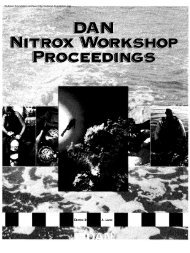Annual Diving Report - Divers Alert Network
Annual Diving Report - Divers Alert Network
Annual Diving Report - Divers Alert Network
You also want an ePaper? Increase the reach of your titles
YUMPU automatically turns print PDFs into web optimized ePapers that Google loves.
APPENDIX B. DIVE FATALITY CASE REPORTS<br />
down to the other divers. The decedent lost consciousness on the surface and could not be<br />
resuscitated. The autopsy disclosed intravascular air in the blood vessels of the brain and heart<br />
as well as pulmonary barotrauma. The dive computer showed several periods of rapid ascent.<br />
The medical examiner certified the death as due to an air embolism.<br />
04-24 Poorly conditioned diver, tobacco abuse, did solo dive, surfaced in distress and lost<br />
consciousness<br />
Cause of Death: Air Embolism due to Pulmonary Barotrauma<br />
This 52-year-old male was a certified diver with an unknown amount of diving experience. The<br />
diver was known to be a heavy smoker. He made a solo descent to approximately 40 fsw (12<br />
msw) to check the anchor. The diver was noted to surface, waving his arms in distress. He then<br />
lost consciousness and could not be resuscitated. The autopsy revealed large amounts of<br />
intravascular gas as well as evidence of pulmonary barotrauma. Natural disease processes<br />
included obesity, mild atherosclerosis of the aorta and pulmonary emphysema, a risk factor for<br />
pulmonary barotrauma.<br />
B.2 Proximate Cause: Drowning / Air Embolism<br />
04-46 Inexperienced, obese diver on weight loss medication made solo shore dive, called<br />
for help and lost consciousness, body found several hours later<br />
Cause of Death: Drowning due to Air Embolism<br />
This 48-year-old female received her open-water certification one month prior to her death and<br />
she had minimal diving experience. She was overweight and used phentermine and fenfluramine<br />
as a method to attempt weight loss. The diver made a shore entry solo dive and was collecting<br />
shells and other items from the bottom. She did not wear a buoyancy compensator and did not<br />
use a buoy or dive flag. She stayed in approximately 15 fsw (5 msw), making numerous<br />
excursions to depth. The diver called out for help prior to losing consciousness. Her body was<br />
recovered from the bottom three hours later. The autopsy disclosed changes associated with<br />
drowning as well as gas in the large veins and the right side of the heart. The medical examiner<br />
felt that the diver had suffered a venous gas embolism but this more likely represents an arterial<br />
gas embolism based on the history. The intracardiac and intravenous gas likely represents a<br />
postmortem change artifact.<br />
04-54 Student in OW class on check out dive, performing towing skill, struggled and lost<br />
consciousness<br />
Cause of Death: Drowning due to Air Embolism<br />
This 50-year-old male was a student in an initial open-water certification class completing his<br />
fourth check-out dive. The dive was with an instructor and one other diver using a shore entry into<br />
a lake. He was practicing rescue procedures and ascended from 15 ffw (5 mfw) prior to towing a<br />
fellow diver as part of the training evolution. While towing the diver the decedent first began to<br />
struggle a little and then lost consciousness. Resuscitation efforts were unsuccessful. The<br />
autopsy disclosed changes associated with drowning as well as intravascular gas. This was most<br />
likely a drowning secondary to an air embolism.<br />
72 <strong>Annual</strong> <strong>Diving</strong> <strong>Report</strong>: 2006 Edition

















